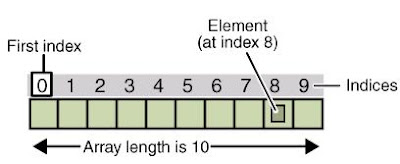Home » Data Structures using Java »
Arrays in Java Programming Language
An array is a container object that holds a fixed number of values of a single type. The length of an array is established when the array is created. After creation, its length is fixed. You've seen an example of arrays already, in the main method of the "Hello World!" application. This section discusses arrays in greater detail.
 |
| An array of ten elements |
Each item in an array is called an element, and each element is accessed by its numerical index. As shown in the above illustration, numbering begins with 0. The 9th element, for example, would therefore be accessed at index 8.
The following program, ArrayDemo, creates an array of integers, puts some values in it, and prints each value to standard output.
class ArrayDemo {
public static void main(String[] args) {
int[] anArray; // declares an array of integers
anArray = new int[10]; // allocates memory for 10 integers
anArray[0] = 100; // initialize first element
anArray[1] = 200; // initialize second element
anArray[2] = 300; // etc.
anArray[3] = 400;
anArray[4] = 500;
anArray[5] = 600;
anArray[6] = 700;
anArray[7] = 800;
anArray[8] = 900;
anArray[9] = 1000;
System.out.println("Element at index 0: " + anArray[0]);
System.out.println("Element at index 1: " + anArray[1]);
System.out.println("Element at index 2: " + anArray[2]);
System.out.println("Element at index 3: " + anArray[3]);
System.out.println("Element at index 4: " + anArray[4]);
System.out.println("Element at index 5: " + anArray[5]);
System.out.println("Element at index 6: " + anArray[6]);
System.out.println("Element at index 7: " + anArray[7]);
System.out.println("Element at index 8: " + anArray[8]);
System.out.println("Element at index 9: " + anArray[9]);
}
}
The output from this program is:
Element at index 0: 100
Element at index 1: 200
Element at index 2: 300
Element at index 3: 400
Element at index 4: 500
Element at index 5: 600
Element at index 6: 700
Element at index 7: 800
Element at index 8: 900
Element at index 9: 1000
In the Java programming language, a multidimensional array is simply an array whose components are themselves arrays. This is unlike arrays in C or Fortran. A consequence of this is that the rows are allowed to vary in length, as shown in the following MultiDimArrayDemo program:
class MultiDimArrayDemo {
public static void main(String[] args) {
String[][] names = {{"Mr. ", "Mrs. ", "Ms. "},
{"Smith", "Jones"}};
System.out.println(names[0][0] + names[1][0]); //Mr. Jones
System.out.println(names[0][2] + names[1][1]); //Ms. Smith
}
}
The output from this program is:
Mr. Jones
Ms. Smith
Related posts:
If you enjoyed this article, subscribe to receive more great content just like it.
Recent Stories
Recent Comments
Tag Cloud
Disclaimer
JUST LIKE IN ANY OTHER BLOGGER IN THE BLOG SPHERE, THIS BLOGGER DOES NOT CLAIM OWNERSHIP IN ANY INFORMATION HEREIN POSTED. INFOTECHGUIDE.BLOGSPOT.COM IS DESIGNED TO PROVIDE BASIC INFORMATION ABOUT INFORMATION TECHNOLOGY THAT INTEREST USUAL ONLINE READERS. IF YOU HAVE ANY CONCERN AND SUGGESTION ABOUT THIS SITE PLEASE FEEL FREE TO CONTACT US OR LEAVE A COMMENT FOR THE APPROPRIATE ADJUSTMENT
Labels
- Computer Tips and Tricks (8)
- Content Management System (1)
- Data Structures using Java (15)
- Database Management Systems (2)
- File Formats (7)
- Gadgets Reviews (2)
- Games Reviews (2)
- hardware (16)
- Internet Terms (7)
- Management Information System (5)
- networking (8)
- Programming (15)
- sofware (17)
- Tech News (4)
- Web Design (4)


0 comments for this post
Leave a reply